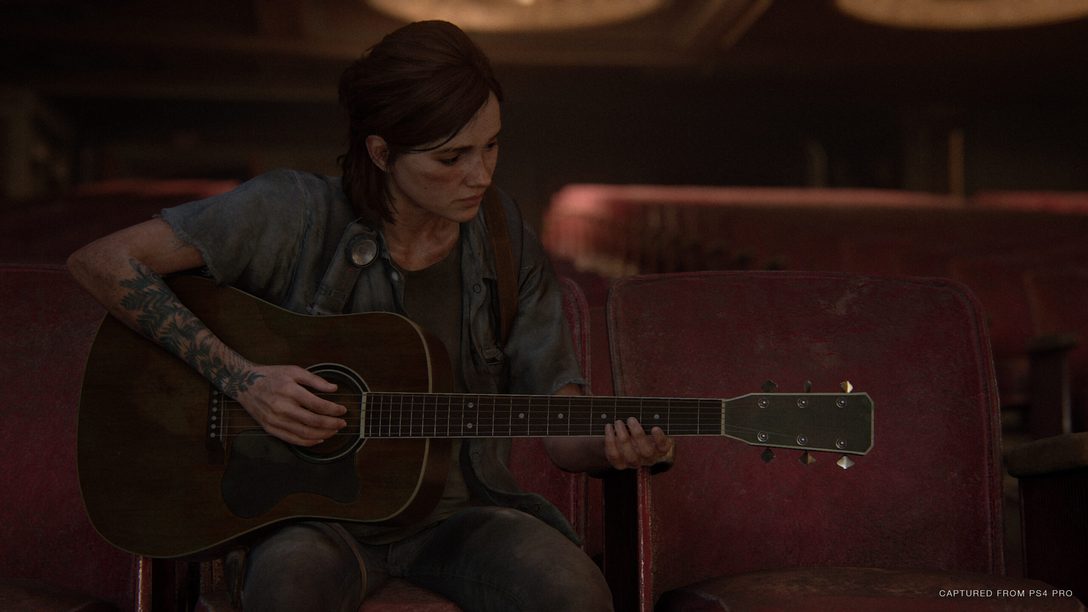
How Ellie’s musical moments expanded from early brainstorms to an expressive game mechanic.
Music has always been a cornerstone of Naughty Dog titles, but with The Last of Us: Part II we knew we wanted to take things a step further, and put the music directly into players’ hands.
The idea sprung first from a narrative angle: between our first internal story pitch and our first external trailer, the guitar was always a story focus. And as designers, we wanted to make the guitar playable from the get go, to make the player feel that connection between Joel and Ellie.
However, the world of The Last of Us is grounded and somber. A flashy guitar mini-game wouldn’t fit the tone of our post-apocalyptic environment. Moreover, Ellie playing guitar shouldn’t be about showing off your skills or fulfilling your dreams of being a rock star, it should be about remembering a loved one and expressing oneself through music to connect to them.
We felt early on, then, that we should avoid rhythm-based games. While those experiences are extremely fun, our tone was better-suited to introspection and expression, rather than high-skill riffs, combos, and the like.
But what are our alternatives? How could we craft a playable guitar that matched our expressive, melancholy tone? We started looking for inspiration not just from existing games, but from music-making apps – tools for people to create music of their own. Of particular note were smartphone music apps, whose touchscreen interfaces got our gears turning about harnessing the DualShock 4 touchpad.
Thankfully, one of the earliest captured cinematics for the game was Ashley Johnson (Ellie) singing “Take on Me” by Aha. So even early on, we had a reference to use as our goal for the minigame. With that target, we asked ourselves how much of the song should the player play before we transition over to the cinematic? Should we try to layer Ashley’s singing over the player playing as we transition? Stepping back, how much freedom do we give the player before we consider it a failure? We saw that a good way to distinguish success from failure was by tracking chord progression but leaving the plucking of strings up to the player. This allows for more musical expression – including things like tempo, time signature, and style – to be determined by the player while still keeping the song recognizable.
Once this “Take On Me” prototype felt solid, we started to consider the rest of the game, and the other songs we needed. We knew “Future Days” by Pearl Jam would be a critical one to figure out, but there were ideas kicking around for other songs as well. Knowing that either way we would need more chord wheels, we started to ask ourselves…how many chords might we need to cover any potential song we might want to include down the line?
This was the origin of our Free Play (Practice) mode. This mode wasn’t our original intention, but rather an idea that emerged from expanding the system to multiple songs. Once we started down the Free Play rabbit hole, we got to lean even further into our goals of player expression. Our goal was to lay out the chord wheels so that they’d be intuitive to players with some musical knowledge, but also allow novices to still sound good even when strumming around randomly with a wheel.
Then came time to actually make it! In classic Naughty Dog fashion, many departments put in tons of work in order to make this guitar mini-game truly sing. There was the mocap data from our awesome actors; our amazing animation team fine tuning finger positions and strumming gestures; our stellar sound and music teams recording different guitars and getting hundreds of individual notes; our fantastic foreground department who made guitars with rotating tuning pegs, vibrating strings, and unique finishes; our kick-butt QA for catching plenty of hairy edge-cases; other designers thoughtfully crafting spaces and placement for these moments; and of course our indispensable UI team who helped us create the chord wheels and visual feedback to help guide players through the process.
Our hope was that this mini-game would work on two levels. First, the narrative beats would carry emotional weight, and players would resonate (eh?) with our characters and with their connections through these songs. Second, our extra special hope was that Practice mode would lead to original content; that players would start covering songs beyond those included in the game. Once the game launched, we were ecstatic to see exactly that! Within a few days, clips started cropping up on social media of players covering, singing along, or even making original music on the in-game guitar. The Naughty Dog team sent a ton of videos back and forth internally of our favorite renditions, so huge shoutout to everyone out there who made something like this! You have no idea how special that was to see.
If you want a more in-depth look at this guitar system, check out our GDC talk if you’d like to learn more. And play on!
The Last of Us Part II is available with the PlayStation Now library until Monday, January 3, 2022.











Comments are closed.
19 Comments
Loading More Comments